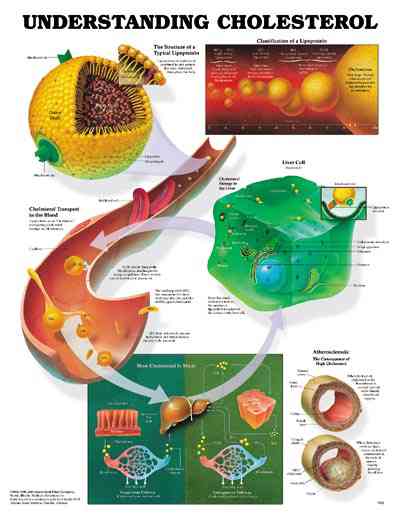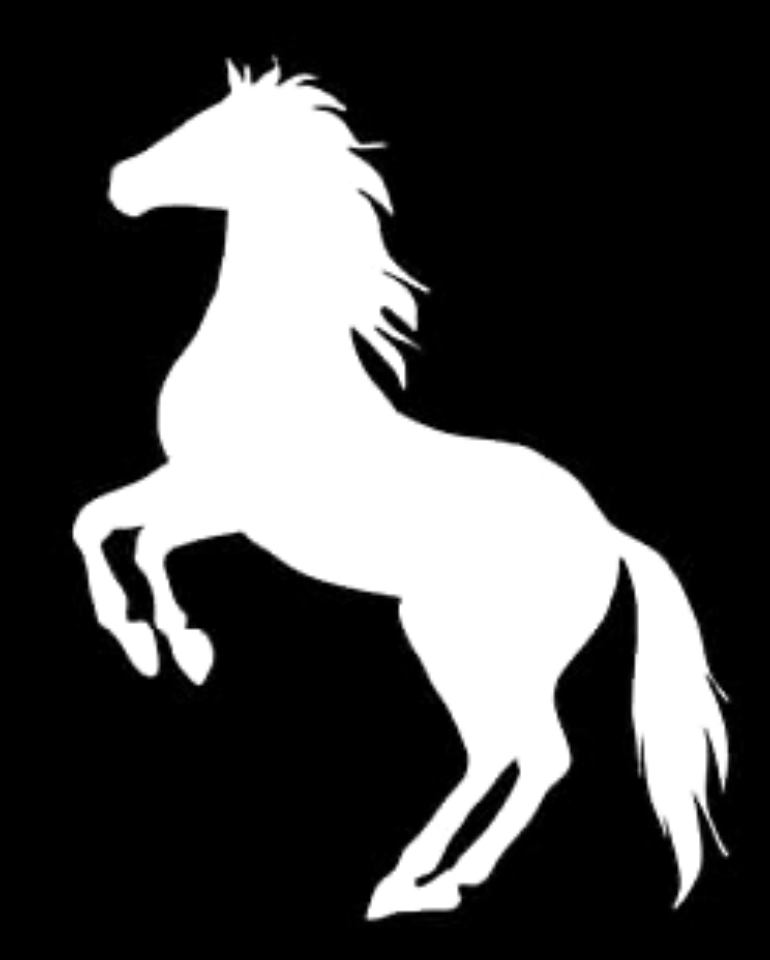| CHOLESTEROL
Eating right can be confusing. With some food, eating more is better. With others, eating less is better. Still other food falls somewhere in between. Cholesterol is a component of certain food and is needed by your body, but if eaten in excess, it's harmful. What is the story on cholesterol?
Cholesterol is found in all food of animal origin, and is also produced by the liver for use in cell membranes, the digestive enzyme bile, and the sex hormones. Because your body makes enough cholesterol to meet its needs, excess cholesterol obtained from food may build up on the walls of the arteries, thickening the walls and impeding the flow of blood in a process called "atherosclerosis.: Over time, the arteries may become damaged so that blood clots lodge in these small vessels, causing a heart attack or stroke. Each year, over one million Americans suffer a heart attack, making it the leading cause of death.
What determines cholesterol levels?
Everyone is born with a particular genetic pattern which influences their cholesterol level; this cannot be changed. However, you can alter your total cholesterol level by changing the amount of fat and cholesterol in your diet. The average American gets excess cholesterol from a diet in which 40% of the calories come from fat. For a healthier diet, the Surgeon General suggests reducing fat intake to 30% of total calories.
The type of fat that you eat is as important as how much you eat. The following chart lists some types of fats and their effect on blood cholesterols levels. Fats are classified as "saturated" when all the carbons of the fatty acid molecule are holding the maximum number of hydrogen atoms. Saturated fats in your diet tend to raise blood cholesterol levels. "Unsaturated" fats are molecules which can accept more hydrogen atoms; when in predominance in your diet, they tend to lower blood cholesterol levels. Specific types of unsaturated fats include "mono-unsaturated" fats which can accept two more hydrogen atoms, and "polyunsaturated" which can accept four or more hydrogen atoms. A type of polyunsaturated fat is the "omega-e" fatty acid, found in fish oil. Unsaturated fats can be made into saturated fats through a process called "hydrogenation" which chemically bonds extra hydrogen atoms to the molecule. Many polyunsaturated fats are hydrogenated during food processing, making the fats more solid--and less healthy.
| Type of Fat |
Form at Room Temperature |
Effect on Cholesterol |
Food Examples |
| Saturated Fat |
solid |
increase |
butter, egg yolk, coconut & palm oil |
| Unsaturated /Monounsaturated |
liquid |
decrease |
olive & peanut oil |
| Polyunsaturated |
soft/liquid |
decrease |
vegetable & fish oil |
How the cholesterol travels through the bloodstream also influences your cholesterol level. The fat-protein complexes which carry cholesterol in the blood are called "lipoproteins"; the two main types are "low density lipoproteins"
(LDL) and "High density lipoproteins" (HDL). LDLs are the lipoproteins that carry cholesterol from the liver to the tissues of the body; when in excess in the blood, these deposit cholesterol and triglycerides (another type of fat) on the inner walls of the blood vessels. LDLs are known as the "bad cholesterol." HDLs are the lipoproteins that carry cholesterol from the cells to the liver for processing excretion. Current research
shows that persons with high HDL levels have a lower risk of heart disease; for this reason, HDL is known as the "good cholesterol." Several factors influence your cholesterol level and promote a lower risk for heart disease.
- Exercising aerobically three or more times a week (20 minutes or more each time) can increase HDL levels.
- Eating a diet rich in fiber helps move digested food through the intestines more rapidly, so that cholesterol and fat may be eliminated.
- If you smoke, quitting will increase the level of HDL in your bloodstream.
Other factors negatively influence cholesterol levels: being overweight causes the liver to increase production of the precursor to LDL and causes more LDL to be carried in the blood. The sex hormones play a role in determining cholesterol levels. Estrogen, the predominant female hormone has been shown to raise HDL levels, while testosterone, and predominant male hormones, can lower
HDL. Eating a diet high in refined sugar has been shown to decrease the level of
HDL. Certain medications also affect cholesterol levels. Getting Blood Cholesterol Tested:
To find out your cholesterol level, have your health care provider take a blood test (after you have fasted 14 hours) and look at the results in terms of total cholesterol level, LDL level, and HDL level. Triglycerides, or the fats stored in the body, are sometimes also measured. "Finger-prick" cholesterol tests can be performed, although these tests are less accurate than the blood sample tests and only identify total cholesterol.
To know what your cholesterol values mean, use the following table.
Risk Level
|
Average |
Moderate |
High |
| Total Cholesterol (mg/dl) |
<200 |
200-239 |
>240 |
| LDL level (mg/dl) |
<130 |
130-159 |
>160 |
| HDL level (mg/dl) |
Overall |
Recommendation: |
>35 |
To plan a low cholesterol diet, be aware of the fat content of food. Reading food labels can help, but use caution: labels frequently claim "conatins no cholesterol," when a careful reading of the ingredient list shows that the product does conatin saturated fat or hydrogenated fats; these can harm your arteries as much as cholesterol, and should be avoided. To calculate what percentage of a food's calories come from fat, use the formula shown below. Remember, 30% or less of your daily calories should come from fat.
gram of fat in food x 9 calories/gram fat
----------------------------------------- = % calories from fat
total calories per serving of food
Although cholesterol is a complicated topic, you don't have to be a nutritionist to know how to lower the cholesterol in your diet. Use the "Fat Calories" chart and the dietary tips to select or cook food which will be low in cholesterol and healthy for your arteries.
Dietary Tips to Reduce Cholesterol Levels
- Choose broiled, baked, or boiled food instead of fried foods.
- Trim exterior fat from meat and remove skin from poultry before cooking.
- Avoid highly saturated fats such as beef fat, butter, cream, lard, coca butter, coconut oil, palm oil, and hydrogenated oils.
- In place of saturated fats, use polyunsaturated fats such as corn, cottonseed, safflower, sesame, soybean, and sunflower oils. Use nonstick cooking sprays to keep food from sticking to pans.
- Eat more seafood rich in omega-3 fatty acids, such as the deep sea, oily fishes (sardines,
mackeral, etc.). Avoid using fish oil capsules; the benefit of these are not clear, and they may be harmful in high doses.
- Eat no more than four eggs a week. When cooking with eggs, discard every other egg yolk and use additional egg whites to increase the volume of the egg.
- Drink low fat or skim milk instead of whole milk.
- Substitute low fat yogurt or cottage cheese for mayonnaise or sour cream in recipes, or replace some of the high fat condiments with vinegar or lemon juice.
Food and Fat -- What to Eat and When
Low-Fat Food to Eat Anytime
(Less than 20% of the calories from fat)
| bread |
skim milk and buttermilk |
| beans, peas, lentils |
soups--bouillon |
| cake--angel food |
consomme, split pea |
| cereal (except granola) |
tuna in water |
| cottage cheese, low fat |
turkey, white meat |
| frozen yogurt, low fat |
vegetables |
| fruit |
grains |
Moderate Fat Food -- Eat No More Than One Serving Daily
(20-50% of calories from fat)
| beef--flank steak, chuck roast, lean T-bone, sirloin |
cake--yellow, white (without icing) |
| chicken |
pizza |
| corn muffins |
seafood--scallops, shrimp |
| cottage cheese |
soups--chicken, beef, |
| fish |
tomato, vegetable |
| ice milk |
tuna in oil |
| milk |
turkey, dark meat |
| nuts, seeds |
yogurt, whole milk |
| pancakes |
|
High-Fat Food--Eat No More Than Several Times Per Week
(More Than 50% of Calories from Fat)
| bacon |
eggs |
| beef--loin, rump, corned, |
frankfurters |
| regular ground |
ice cream |
| cake-pound |
lamb |
| cheese |
olives |
| chocolate |
peanut butter |
| coconut |
pork |
| cold cuts |
tuna salad |
| coleslaw |
veal |
| cream |
cream cheese |
**ALL FOOD FROM ANIMAL ORIGIN CONTAINS CHOLESTEROL**
Chart adapted from Jane Brody's Nutrition Book
For more information about fat, the "Nutrition Wiz" diet analysis service, or your health, contact the Department of
Health Education at (732)932-7710.


Information compliments of Rutgers University
 
|
 Historical Web Sites
Historical Web Sites

 Historical Web Sites
Historical Web Sites
